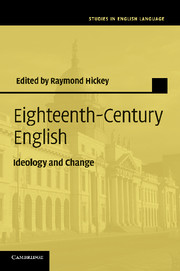Book contents
- Frontmatter
- Contents
- List of figures
- List of maps
- List of tables
- Notes on contributors
- Preface
- 1 Attitudes and concerns in eighteenth-century English
- 2 Prescriptivism and the suppression of variation
- 3 Women's grammars
- 4 Eighteenth-century women and their norms of correctness
- 5 Lowth as an icon of prescriptivism
- 6 Queeney Thrale and the teaching of English grammar
- 7 Coalitions, networks, and discourse communities in Augustan England: The Spectator and the early eighteenth-century essay
- 8 Contextualising eighteenth-century politeness: social distinction and metaphorical levelling
- 9 Expressive speech acts and politeness in eighteenth-century English
- 10 Variation and change in eighteenth-century English
- 11 Variation in sentential complements in eighteenth- and nineteenth-century English: a processing-based explanation
- 12 Nationality and standardisation in eighteenth-century Scotland
- 13 English in eighteenth-century Ireland
- 14 Changes and continuities in dialect grammar
- 15 ‘Be pleased to report expressly’: the development of a public style in Late Modern English business and official correspondence
- 16 Registering the language – dictionaries, diction and the art of elocution
- Timeline for the eighteenth century
- References
- Late modern English language studies
- Indexes
6 - Queeney Thrale and the teaching of English grammar
Published online by Cambridge University Press: 06 December 2010
- Frontmatter
- Contents
- List of figures
- List of maps
- List of tables
- Notes on contributors
- Preface
- 1 Attitudes and concerns in eighteenth-century English
- 2 Prescriptivism and the suppression of variation
- 3 Women's grammars
- 4 Eighteenth-century women and their norms of correctness
- 5 Lowth as an icon of prescriptivism
- 6 Queeney Thrale and the teaching of English grammar
- 7 Coalitions, networks, and discourse communities in Augustan England: The Spectator and the early eighteenth-century essay
- 8 Contextualising eighteenth-century politeness: social distinction and metaphorical levelling
- 9 Expressive speech acts and politeness in eighteenth-century English
- 10 Variation and change in eighteenth-century English
- 11 Variation in sentential complements in eighteenth- and nineteenth-century English: a processing-based explanation
- 12 Nationality and standardisation in eighteenth-century Scotland
- 13 English in eighteenth-century Ireland
- 14 Changes and continuities in dialect grammar
- 15 ‘Be pleased to report expressly’: the development of a public style in Late Modern English business and official correspondence
- 16 Registering the language – dictionaries, diction and the art of elocution
- Timeline for the eighteenth century
- References
- Late modern English language studies
- Indexes
Summary
Introduction
On 1 February 1770 Hester Lynch Thrale (later Piozzi) (1741−1821), an eighteenth-century literary hostess best known as a friend of Dr Johnson's, noted in her journal that her daughter:
Hester Maria Thrale was four Years and nine Months old when I lay in of Lucy; and then I first began to teach her Grammar shewing her the Difference between a Substantive and an Adjective as I lay in Bed.
(Hyde 1977: 34)Hester Maria, otherwise known as Queeney (1764−1857), a nickname none other than Dr Johnson had given to her, may have been a precocious child (see Navest 2003: 1−2), but teaching grammar to such young children was by no means unusual at the time. According to Michael (1970: 550), the Reverend John Ash (1724?–79) of Pershore in Worcestershire wrote his Grammatical Institutes: or Grammar, Adapted to the Genius of the English Tongue (1760) for his five-year-old daughter, who ‘learnt and repeated the whole in a short Time’ (Ash 1766: Advertisement). It was Ash's grammar which the novelist Fanny Burney (1752–1840) used while teaching her six-year-old son Alexander the rudiments of grammar in 1801 (Percy 1994: 127).
Even Robert Lowth's (1710–87) popular and authoritative Short Introduction to English Grammar (1762) was originally begun as a grammar for his son Thomas Henry (1753–78), who was about four years old at the time (Tieken-Boon van Ostade 2000b: 25–6; 2003: 43).
- Type
- Chapter
- Information
- Eighteenth-Century EnglishIdeology and Change, pp. 89 - 105Publisher: Cambridge University PressPrint publication year: 2010



